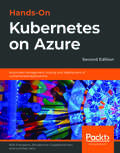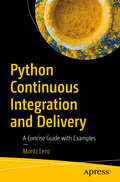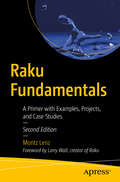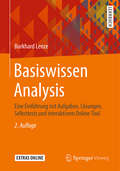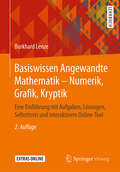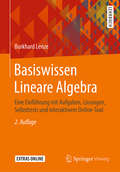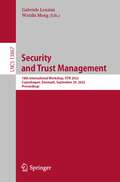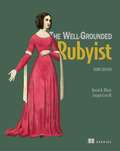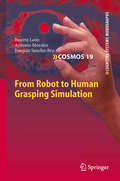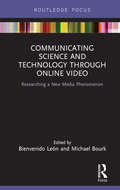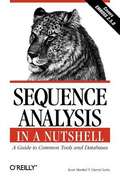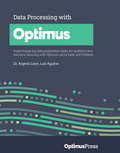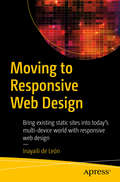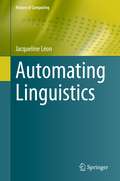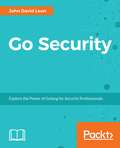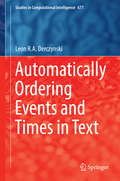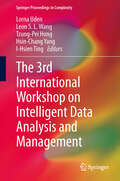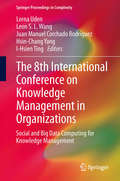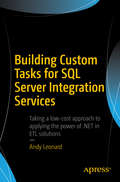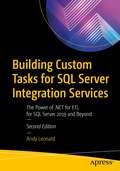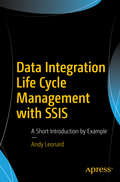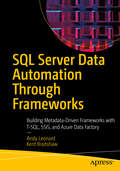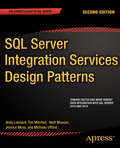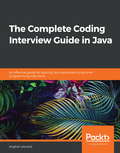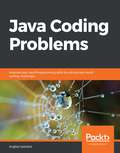- Table View
- List View
Hands-On Kubernetes on Azure: Automate management, scaling, and deployment of containerized applications, 2nd Edition
by Gunther Lenz Shivakumar Gopalakrishnan Nills FranssensKick-start your DevOps career by learning how to effectively deploy Kubernetes on Azure in an easy, comprehensive, and fun way with hands-on coding tasks Key Features Understand the fundamentals of Docker and Kubernetes Learn to implement microservices architecture using the Kubernetes platform Discover how you can scale your application workloads in Azure Kubernetes Service (AKS) Book Description From managing versioning efficiently to improving security and portability, technologies such as Kubernetes and Docker have greatly helped cloud deployments and application development. Starting with an introduction to Docker, Kubernetes, and Azure Kubernetes Service (AKS), this book will guide you through deploying an AKS cluster in different ways. You'll then explore the Azure portal by deploying a sample guestbook application on AKS and installing complex Kubernetes apps using Helm. With the help of real-world examples, you'll also get to grips with scaling your application and cluster. As you advance, you'll understand how to overcome common challenges in AKS and secure your application with HTTPS and Azure AD (Active Directory). Finally, you'll explore serverless functions such as HTTP triggered Azure functions and queue triggered functions. By the end of this Kubernetes book, you'll be well-versed with the fundamentals of Azure Kubernetes Service and be able to deploy containerized workloads on Microsoft Azure with minimal management overhead. What you will learn Plan, configure, and run containerized applications in production Use Docker to build apps in containers and deploy them on Kubernetes Improve the configuration and deployment of apps on the Azure Cloud Store your container images securely with Azure Container Registry Install complex Kubernetes applications using Helm Integrate Kubernetes with multiple Azure PaaS services, such as databases, Event Hubs and Functions. Who this book is for This book is for aspiring DevOps professionals, system administrators, developers, and site reliability engineers looking to understand test and deployment processes and improve their efficiency. If you're new to working with containers and orchestration, you'll find this book useful.
Python Continuous Integration and Delivery: A Concise Guide with Examples
by Moritz LenzGain the techniques and tools that enable a smooth and efficient software development process in this quick and practical guide on Python continuous integration (CI) and continuous delivery (CD). Based on example applications, this book introduces various kinds of testing and shows you how to set up automated systems that run these tests, and install applications in different environments in controlled ways. Python Continuous Integration and Delivery tackles the technical problems related to software development that are typically glossed over in pure programming texts.After reading this book, you’ll see that in today's fast-moving world, no software project can afford to go through development, then an integration phase of unpredictable length and complexity, and finally be shipped to the customer -- just to find out that the resulting application didn't quite fill their need. Instead, you’ll discover that practicing continuous integration and continuous delivery reduces the risks by keeping changes small and automating otherwise painful processes. What You Will LearnCarry out various kinds of testing, including unit testing and continuous integration testing, of your Python code using JenkinsBuild packages and manage repositoriesIncorporate Ansible and Go for automated packaging and other deploymentsManage more complex and robust deploymentsWho This Book Is ForPython programmers and operating staff that work with Python applications.
Raku Fundamentals: A Primer with Examples, Projects, and Case Studies
by Moritz LenzGain the skills to begin developing Raku applications from the ground up in this hands-on compact book, which includes a foreword from Larry Wall, creator of Perl. You’ll learn enough to get started building with Raku, using Raku's gradual typing, handy object orientated features, powerful parsing capabilities, and human-usable concurrency. This book has been updated to include the latest version of Raku based upon the Perl 6.d major version which includes over 3,400 new commits in its specification. After a short introduction, each chapter develops a small example project, explaining the Raku features used. When the example is done, you’ll explore another aspect, such as optimizing further for readability or testing the code. Along the way you’ll see Raku basics, such as variables and scoping; subroutines; classes and objects; regexes; and code testing. When you’ve mastered the basics, Raku Fundamentals moves onto more advanced topics to give you a deeper understanding of the language. You’ll learn, amongst other things, how to work with persistent storage, how to generate good error messages, and how to write tricky applications such as a file and directory usage graph and a Unicode search tool. What You Will Learn Get coding with latest version of Raku Work on several hands-on examples and projects Integrate Python libraries into your Raku-based programs Parse INI files using regexes and grammars Build a date-time converter Carry out refactoring and other automated tests Who This Book Is For If you already know one or more programming languages, and want to learn about Raku, then this book is for you.
Basiswissen Analysis: Eine Einführung mit Aufgaben, Lösungen, Selbsttests und interaktivem Online-Tool
by Burkhard LenzeDieses Buch bietet eine schlanke und gut zugängliche Hinführung zur Analysis. Gut 100 komplett durchgerechnete Beispiele, etwa 50 Aufgaben mit Lösungen sowie rund 40 kleine Selbsttests mit Antworten erleichtern den Zugang zum Thema. Abgerundet wird das Ganze durch etwa 80 Skizzen im Text sowie ein online verfügbares interaktives pdf-Tool zum Generieren von Zufallsaufgaben inklusive Lösungen. Das Buch richtet sich an Studierende in Studiengängen mit mathematischen Pflichtveranstaltungen im Grundstudium an Universitäten und Fachhochschulen. Es ist sowohl als Begleitlektüre für entsprechende Vorlesungen als auch zum Selbststudium optimal geeignet.
Basiswissen Angewandte Mathematik – Numerik, Grafik, Kryptik: Eine Einführung mit Aufgaben, Lösungen, Selbsttests und interaktivem Online-Tool
by Burkhard LenzeDieses Buch bietet eine schlanke und gut zugängliche Hinführung zur Angewandten Mathematik, speziell zur Numerischen Mathematik, Aspekten der Computer-Grafik sowie der Verschlüsselungstechnik. Rund 140 komplett durchgerechnete Beispiele, gut 100 Aufgaben mit Lösungen sowie etwa 50 Selbsttests mit Lösungen erleichtern den Zugang zum Thema. Abgerundet wird das Ganze durch etwa 80 Skizzen im Text sowie ein online verfügbares interaktives pdf-Tool zum Generieren von Zufallsaufgaben inklusive Lösungen. Das Buch richtet sich an Studierende in Studiengängen mit mathematischen Pflichtveranstaltungen im Grundstudium an Universitäten und Fachhochschulen. Es ist sowohl als Begleitlektüre für entsprechende Vorlesungen als auch zum Selbststudium optimal geeignet.
Basiswissen Lineare Algebra: Eine Einführung mit Aufgaben, Lösungen, Selbsttests und interaktivem Online-Tool
by Burkhard LenzeDieses Buch bietet eine schlanke und gut zugängliche Hinführung zur Linearen Algebra. Knapp 200 komplett durchgerechnete Beispiele, gut 100 Aufgaben mit Lösungen sowie rund 50 Selbsttests mit Lösungen erleichtern den Zugang zum Thema. Abgerundet wird das Ganze durch etwa 60 Skizzen im Text sowie ein online verfügbares interaktives pdf-Tool zum Generieren von Zufallsaufgaben inklusive Lösungen. Das Buch richtet sich an Studierende in Studiengängen mit mathematischen Pflichtveranstaltungen im Grundstudium an Universitäten und Fachhochschulen. Es ist sowohl als Begleitlektüre für entsprechende Vorlesungen als auch zum Selbststudium optimal geeignet.
Security and Trust Management: 18th International Workshop, STM 2022, Copenhagen, Denmark, September 29, 2022, Proceedings (Lecture Notes in Computer Science #13867)
by Gabriele Lenzini Weizhi MengThis book constitutes the post proceedings of the 18th International Workshop on Security and Trust Management, STM 2022, co-located with the 27th European Symposium on Research in Computer Security, ESORICS 2022, which took place in Copenhagen, Denmark, in September 2022.The 7 full papers together with 4 short papers included in this volume were carefully reviewed and selected from 18 submissions. The workshop presents papers with topics such as security and trust access control, cryptographic protocols, identity management, security metrics, and privacy.
The Well-Grounded Rubyist
by Joe LeoSummaryThe Well-Grounded Rubyist, Third Edition is a beautifully written tutorial that begins with your first Ruby program and takes you all the way to sophisticated topics like reflection, threading, and recursion. Ruby masters David A. Black and Joe Leo distill their years of knowledge for you, concentrating on the language and its uses so you can use Ruby in any way you choose. Updated for Ruby 2.5.Purchase of the print book includes a free eBook in PDF, Kindle, and ePub formats from Manning Publications.About the TechnologyDesigned for developer productivity, Ruby is an easy-to-learn dynamic language perfect for creating virtually any kind of software. Its famously friendly development community, countless libraries, and amazing tools, like the Rails framework, have established it as the language of choice for high-profile companies, including GitHub, SlideShare, and Shopify. The future is bright for the well-grounded Rubyist!About the BookIn The Well-Grounded Rubyist, Third Edition, expert authors David A. Black and Joseph Leo deliver Ruby mastery in an easy-to-read, casual style. You'll lock in core principles as you write your first Ruby programs. Then, you'll progressively build up to topics like reflection, threading, and recursion, cementing your knowledge with high-value exercises to practice your skills along the way.What's InsideBasic Ruby syntaxRunning Ruby extensionsFP concepts like currying, side-effect-free code, and recursionRuby 2.5 updatesAbout the ReaderFor readers with beginner-level programming skills.About the AuthorsDavid A. Black is an internationally known Ruby developer and author, and a cofounder of Ruby Central. Ruby teacher and advocate Joseph Leo III is the founder of Def Method and lead organizer of the Gotham Ruby Conference. Table of ContentsPART 1 RUBY FOUNDATIONSBootstrapping your Ruby literacyObjects, methods, and local variablesOrganizing objects with classesModules and program organizationThe default object (self), scope, and visibilityControl-flow techniquesPART 2 BUILT-IN CLASSES AND MODULESBuilt-in essentialsStrings, symbols, and other scalar objectsCollection and container objectsCollections central: Enumerable and EnumeratorRegular expressions and regexp-based string operationsFile and I/O operationsPART 3 RUBY DYNAMICSObject individuationCallable and runnable objectsCallbacks, hooks, and runtime introspectionRuby and functional programming
From Robot to Human Grasping Simulation
by Beatriz León Antonio Morales Joaquín Sancho-BruThe human hand and its dexterity in grasping and manipulating objects are some of the hallmarks of the human species. For years, anatomic and biomechanical studies have deepened the understanding of the human hand's functioning and, in parallel, the robotics community has been working on the design of robotic hands capable of manipulating objects with a performance similar to that of the human hand. However, although many researchers have partially studied various aspects, to date there has been no comprehensive characterization of the human hand's function for grasping and manipulation of everyday life objects. This monograph explores the hypothesis that the confluence of both scientific fields, the biomechanical study of the human hand and the analysis of robotic manipulation of objects, would greatly benefit and advance both disciplines through simulation. Therefore, in this book, the current knowledge of robotics and biomechanics guides the design and implementation of a simulation framework focused on manipulation interactions that allows the study of the grasp through simulation. As a result, a valuable framework for the study of the grasp, with relevant applications in several fields such as robotics, biomechanics, ergonomics, rehabilitation and medicine, has been made available to these communities.
Communicating Science and Technology Through Online Video: Researching a New Media Phenomenon (Routledge Focus on Communication Studies)
by Bienvenido León Michael BourkOnline video’s unique capacity to reach large audiences makes it a powerful tool to communicate science and technology to the general public. The outcome of the international research project "Videonline," this book provides a unique insight into the key elements of online science videos, such as narrative trends, production characteristics, and issues of scientific rigor. If offers various methodological approaches: a literature review, content analysis, and interviews and surveys of expert practitioners to provide information on how to maintain standards of rigour and technical quality in video production.
Sequence Analysis in a Nutshell
by Darryl Leon Scott MarkelSequence Analysis in a Nutshell: A Guide to Common Tools and Databasespulls together all of the vital information about the most commonly used databases, analytical tools, and tables used in sequence analysis. The book contains details and examples of the common database formats (GenBank, EMBL, SWISS-PROT) and the GenBank/EMBL/DDBJ Feature Table Definitions. It also provides the command line syntax for popular analysis applications such as Readseq and MEME/MAST, BLAST, ClustalW, and the EMBOSS suite, as wel
Data Processing with Optimus: Supercharge big data preparation tasks for analytics and machine learning with Optimus using Dask and PySpark
by Dr. Argenis Leon Luis AguirreWritten by the core Optimus team, this comprehensive guide will help you to understand how Optimus improves the whole data processing landscapeKey FeaturesLoad, merge, and save small and big data efficiently with OptimusLearn Optimus functions for data analytics, feature engineering, machine learning, cross-validation, and NLPDiscover how Optimus improves other data frame technologies and helps you speed up your data processing tasksBook DescriptionOptimus is a Python library that works as a unified API for data cleaning, processing, and merging data. It can be used for handling small and big data on your local laptop or on remote clusters using CPUs or GPUs.The book begins by covering the internals of Optimus and how it works in tandem with the existing technologies to serve your data processing needs. You'll then learn how to use Optimus for loading and saving data from text data formats such as CSV and JSON files, exploring binary files such as Excel, and for columnar data processing with Parquet, Avro, and OCR. Next, you'll get to grips with the profiler and its data types - a unique feature of Optimus Dataframe that assists with data quality. You'll see how to use the plots available in Optimus such as histogram, frequency charts, and scatter and box plots, and understand how Optimus lets you connect to libraries such as Plotly and Altair. You'll also delve into advanced applications such as feature engineering, machine learning, cross-validation, and natural language processing functions and explore the advancements in Optimus. Finally, you'll learn how to create data cleaning and transformation functions and add a hypothetical new data processing engine with Optimus.By the end of this book, you'll be able to improve your data science workflow with Optimus easily.What you will learnUse over 100 data processing functions over columns and other string-like valuesReshape and pivot data to get the output in the required formatFind out how to plot histograms, frequency charts, scatter plots, box plots, and moreConnect Optimus with popular Python visualization libraries such as Plotly and AltairApply string clustering techniques to normalize stringsDiscover functions to explore, fix, and remove poor quality dataUse advanced techniques to remove outliers from your dataAdd engines and custom functions to clean, process, and merge dataWho this book is forThis book is for Python developers who want to explore, transform, and prepare big data for machine learning, analytics, and reporting using Optimus, a unified API to work with Pandas, Dask, cuDF, Dask-cuDF, Vaex, and Spark. Although not necessary, beginner-level knowledge of Python will be helpful. Basic knowledge of the CLI is required to install Optimus and its requirements. For using GPU technologies, you'll need an NVIDIA graphics card compatible with NVIDIA's RAPIDS library, which is compatible with Windows 10 and Linux.
Moving to Responsive Web Design
by Inayaili De LeónRedesign your static website into a modern, fully responsive website. As the usage of mobile devices of all shapes and sizes increases exponentially every year, and dominates the manner in which many users access the web, it is now imperative for any business to have a responsive website that adapts seamlessly to any screen size and resolution — a change that will impact not only your designs but the way you build your site.Moving to Responsive Web Design shows you how to convert fixed grids, previously built on absolute units such as pixels, into fluid ones, based on relative units such as percentages or ems. You will also learn to plan how your designs and patterns will adapt across various breakpoints, and how to approach the challenge of responsive images.The prospect of converting an existing site into responsive design, when you don’t have all the time in the world and your resources are already outstretched, can be daunting, but with this book and the right tools you can tame the scope of the project from the start and find the time for you and your team to work on making your site enjoyable on any device. Moving to Responsive Web Design is full of ideas and examples of how you can more easily plan, design, develop, and release, your responsively redesigned site.Provides ways of finding time in your hectic schedule to complete a project that is truly important Helps you to scope a responsive redesign project so it’s achievable with the resources you have availableProvides examples of how other teams have solved some of the most common problems What You Will LearnFind the time in your busy schedule to redesign your site.Engage the entire team in the plan, design and development process.Use your resources in clever and efficient ways.Focus on reusability to save your team time and money.Release your first fully responsive site.Who This Book is ForBusy designers, and developers who want to convert an existing site to responsive design and don’t have all the time in the world. It’s for teams who know that the move to having a responsive site is the right one, but are struggling to find the time and resources to fit such an expansive project into their already overflowing schedules.
Automating Linguistics (History of Computing)
by Jacqueline LéonAutomating Linguistics offers an in-depth study of the history of the mathematisation and automation of the sciences of language. In the wake of the first mathematisation of the 1930s, two waves followed: machine translation in the 1950s and the development of computational linguistics and natural language processing in the 1960s. These waves were pivotal given the work of large computerised corpora in the 1990s and the unprecedented technological development of computers and software.Early machine translation was devised as a war technology originating in the sciences of war, amidst the amalgamate of mathematics, physics, logics, neurosciences, acoustics, and emerging sciences such as cybernetics and information theory. Machine translation was intended to provide mass translations for strategic purposes during the Cold War. Linguistics, in turn, did not belong to the sciences of war, and played a minor role in the pioneering projects of machine translation.Comparing the two trends, the present book reveals how the sciences of language gradually integrated the technologies of computing and software, resulting in the second-wave mathematisation of the study of language, which may be called mathematisation-automation. The integration took on various shapes contingent upon cultural and linguistic traditions (USA, ex-USSR, Great Britain and France). By contrast, working with large corpora in the 1990s, though enabled by unprecedented development of computing and software, was primarily a continuation of traditional approaches in the sciences of language sciences, such as the study of spoken and written texts, lexicography, and statistical studies of vocabulary.
Security with Go: Explore the power of Golang to secure host, web, and cloud services
by John Daniel LeonThe first stop for your security needs when using Go, covering host, network, and cloud security for ethical hackers and defense against intrusion Key Features First introduction to Security with Golang Adopting a Blue Team/Red Team approach Take advantage of speed and inherent safety of Golang Works as an introduction to security for Golang developers Works as a guide to Golang security packages for recent Golang beginners Book Description Go is becoming more and more popular as a language for security experts. Its wide use in server and cloud environments, its speed and ease of use, and its evident capabilities for data analysis, have made it a prime choice for developers who need to think about security. Security with Go is the first Golang security book, and it is useful for both blue team and red team applications. With this book, you will learn how to write secure software, monitor your systems, secure your data, attack systems, and extract information. Defensive topics include cryptography, forensics, packet capturing, and building secure web applications. Offensive topics include brute force, port scanning, packet injection, web scraping, social engineering, and post exploitation techniques. What you will learn Learn the basic concepts and principles of secure programming Write secure Golang programs and applications Understand classic patterns of attack Write Golang scripts to defend against network-level attacks Learn how to use Golang security packages Apply and explore cryptographic methods and packages Learn the art of defending against brute force attacks Secure web and cloud applications Who this book is for Security with Go is aimed at developers with basics in Go to the level that they can write their own scripts and small programs without difficulty. Readers should be familiar with security concepts, and familiarity with Python security applications and libraries is an advantage, but not a necessity.
Automatically Ordering Events and Times in Text (Studies in Computational Intelligence #677)
by Leon R.A. DerczynskiThe book offers a detailed guide to temporal ordering, exploring open problems in the field and providing solutions and extensive analysis. It addresses the challenge of automatically ordering events and times in text. Aided by TimeML, it also describes and presents concepts relating to time in easy-to-compute terms. Working out the order that events and times happen has proven difficult for computers, since the language used to discuss time can be vague and complex. Mapping out these concepts for a computational system, which does not have its own inherent idea of time, is, unsurprisingly, tough. Solving this problem enables powerful systems that can plan, reason about events, and construct stories of their own accord, as well as understand the complex narratives that humans express and comprehend so naturally. This book presents a theory and data-driven analysis of temporal ordering, leading to the identification of exactly what is difficult about the task. It then proposes and evaluates machine-learning solutions for the major difficulties. It is a valuable resource for those working in machine learning for natural language processing as well as anyone studying time in language, or involved in annotating the structure of time in documents.
The 3rd International Workshop on Intelligent Data Analysis and Management
by Leon S.L. Wang Tzung-Pei Hong Lorna Uden I-Hsien Ting Hsin-Chang YangThese papers on Intelligent Data Analysis and Management (IDAM) examine issues related to the research and applications of Artificial Intelligence techniques in data analysis and management across a variety of disciplines. The papers derive from the 2013 IDAM conference in Kaohsiung ,Taiwan. It is an interdisciplinary research field involving academic researchers in information technologies, computer science, public policy, bioinformatics, medical informatics, and social and behavior studies, etc. The techniques studied include (but are not limited to): data visualization, data pre-processing, data engineering, database mining techniques, tools and applications, evolutionary algorithms, machine learning, neural nets, fuzzy logic, statistical pattern recognition, knowledge filtering, and post-processing, etc.
The 8th International Conference on Knowledge Management in Organizations: Social and Big Data Computing for Knowledge Management
by Leon S.L. Wang Juan Manuel Corchado Rodríguez Lorna Uden I-Hsien Ting Hsin-Chang YangThe proceedings from the eighth KMO conference represent the findings of this international meeting which brought together researchers and developers from industry and the academic world to report on the latest scientific and technical advances on knowledge management in organizations. This conference provided an international forum for authors to present and discuss research focused on the role of knowledge management for innovative services in industries, to shed light on recent advances in social and big data computing for KM as well as to identify future directions for researching the role of knowledge management in service innovation and how cloud computing can be used to address many of the issues currently facing KM in academia and industrial sectors.
Building Custom Tasks for SQL Server Integration Services
by Andy LeonardLearn to build custom SSIS tasks using Visual Studio Community Edition and Visual Basic. Bring all the power of Microsoft . NET to bear on your data integration and ETL processes, and for no added cost over what you've already spent on licensing SQL Server. If you already have a license for SQL Server, then you do not need to spend more money to extend SSIS with custom tasks and components. Why are custom components necessary? Because even though the SSIS catalog of built-in tasks and components is a marvel of engineering, there do remain gaps in the functionality that is provided. These gaps are especially relevant to enterprises practicing Data Integration Lifecycle Management (DILMS) and/or DevOps. One of the gaps is a limitation of the SSIS Execute Package task. Developers using the stock version of that task are unable to select SSIS packages from other projects. Yet it's useful to be able to select and execute tasks across projects, and the example used throughout this book will help you to create an Execute Catalog Package task that does in fact allow you to execute a task from another project. Building on the example's pattern, you can create any task that you like, custom tailored to your specific, data integration and ETL needs. What You Will Learn Configure and execute Visual Studio in the way that best supports SSIS task development Create a class library as the basis for an SSIS task, and reference the needed SSIS assemblies Properly sign assemblies that you create in order to invoke them from your task Implement source code control via Visual Studio Team Services, or your own favorite tool set Code not only your tasks themselves, but also the associated task editors Troubleshoot and then execute your custom tasks as part of your own project Who This Book Is For Database administrators and developers who are involved in ETL projects built around SQL Server Integration Services (SSIS). Readers should have a background in programming along with a desire to optimize their ETL efforts by creating custom-tailored tasks for execution from SSIS packages.
Building Custom Tasks for SQL Server Integration Services: The Power of .NET for ETL for SQL Server 2019 and Beyond
by Andy LeonardBuild custom SQL Server Integration Services (SSIS) tasks using Visual Studio Community Edition and C#. Bring all the power of Microsoft .NET to bear on your data integration and ETL processes, and for no added cost over what you’ve already spent on licensing SQL Server. New in this edition is a demonstration deploying a custom SSIS task to the Azure Data Factory (ADF) Azure-SSIS Integration Runtime (IR). All examples in this new edition are implemented in C#. Custom task developers are shown how to implement custom tasks using the widely accepted and default language for .NET development. Why are custom components necessary? Because even though the SSIS catalog of built-in tasks and components is a marvel of engineering, gaps remain in the available functionality. One such gap is a constraint of the built-in SSIS Execute Package Task, which does not allow SSIS developers to select SSIS packages from other projects in the SSIS Catalog. Examples in this book show how to create a custom Execute Catalog Package task that allows SSIS developers to execute tasks from other projects in the SSIS Catalog. Building on the examples and patterns in this book, SSIS developers may create any task to which they aspire, custom tailored to their specific data integration and ETL needs. What You Will LearnConfigure and execute Visual Studio in the way that best supports SSIS task developmentCreate a class library as the basis for an SSIS task, and reference the needed SSIS assembliesProperly sign assemblies that you create in order to invoke them from your taskImplement source code control via Azure DevOps, or your own favorite tool setTroubleshoot and execute custom tasks as part of your own projectsCreate deployment projects (MSIs) for distributing code-complete tasksDeploy custom tasks to Azure Data Factory Azure-SSIS IRs in the cloudCreate advanced editors for custom task parametersWho This Book Is ForFor database administrators and developers who are involved in ETL projects built around SQL Server Integration Services (SSIS). Readers do not need a background in software development with C#. Most important is a desire to optimize ETL efforts by creating custom-tailored tasks for execution in SSIS packages, on-premises or in ADF Azure-SSIS IRs.
Data Integration Life Cycle Management with SSIS: A Short Introduction By Example
by Andy LeonardBuild a custom BimlExpress framework that generates dozens of SQL Server Integration Services (SSIS) packages in minutes. Use this framework to execute related SSIS packages in a single command. You will learn to configure SSIS catalog projects, manage catalog deployments, and monitor SSIS catalog execution and history. Data Integration Life Cycle Management with SSIS shows you how to bring DevOps benefits to SSIS integration projects. Practices in this book enable faster time to market, higher quality of code, and repeatable automation. Code will be created that is easier to support and maintain. The book teaches you how to more effectively manage SSIS in the enterprise environment by drawing on the art and science of modern DevOps practices. What You'll Learn Generate dozens of SSIS packages in minutes to speed your integration projects Reduce the execution of related groups of SSIS packages to a single command Successfully handle SSIS catalog deployments and their projects Monitor the execution and history of SSIS catalog projects Manage your enterprise data integration life cycle through automated tools and utilities Who This Book Is For Database professionals working with SQL Server Integration Services in enterprise environments. The book is especially useful to those readers following, or wishing to follow, DevOps practices in their use of SSIS.
SQL Server Data Automation Through Frameworks: Building Metadata-Driven Frameworks with T-SQL, SSIS, and Azure Data Factory
by Andy Leonard Kent BradshawLearn to automate SQL Server operations using frameworks built from metadata-driven stored procedures and SQL Server Integration Services (SSIS). Bring all the power of Transact-SQL (T-SQL) and Microsoft .NET to bear on your repetitive data, data integration, and ETL processes. Do this for no added cost over what you’ve already spent on licensing SQL Server. The tools and methods from this book may be applied to on-premises and Azure SQL Server instances. The SSIS framework from this book works in Azure Data Factory (ADF) and provides DevOps personnel the ability to execute child packages outside a project—functionality not natively available in SSIS.Frameworks not only reduce the time required to deliver enterprise functionality, but can also accelerate troubleshooting and problem resolution. You'll learn in this book how frameworks also improve code quality by using metadata to drive processes. Much of the work performed by data professionals can be classified as “drudge work”—tasks that are repetitive and template-based. The frameworks-based approach shown in this book helps you to avoid that drudgery by turning repetitive tasks into "one and done" operations. Frameworks as described in this book also support enterprise DevOps with built-in logging functionality.What You Will LearnCreate a stored procedure framework to automate SQL process executionBase your framework on a working system of stored procedures and execution loggingCreate an SSIS framework to reduce the complexity of executing multiple SSIS packagesDeploy stored procedure and SSIS frameworks to Azure Data Factory environments in the cloudWho This Book Is ForDatabase administrators and developers who are involved in enterprise data projects built around stored procedures and SQL Server Integration Services (SSIS). Readers should have a background in programming along with a desire to optimize their data efforts by implementing repeatable processes that support enterprise DevOps.
SQL Server Integration Services Design Patterns
by Andy Leonard Tim Mitchell Matt Masson Jessica Moss Michelle UffordSQL Server Integration Services Design Patterns is newly-revised for SQL Server 2014, and is a book of recipes for SQL Server Integration Services (SSIS). Design patterns in the book help to solve common problems encountered when developing data integration solutions. The patterns and solution examples in the book increase your efficiency as an SSIS developer, because you do not have to design and code from scratch with each new problem you face. The book's team of expert authors take you through numerous design patterns that you'll soon be using every day, providing the thought process and technical details needed to support their solutions. SQL Server Integration Services Design Patterns goes beyond the surface of the immediate problems to be solved, delving into why particular problems should be solved in certain ways. You'll learn more about SSIS as a result, and you'll learn by practical example. Where appropriate, the book provides examples of alternative patterns and discusses when and where they should be used. Highlights of the book include sections on ETL Instrumentation, SSIS Frameworks, Business Intelligence Markup Language, and Dependency Services. Takes you through solutions to common data integration challengesProvides examples involving Business Intelligence Markup LanguageTeaches SSIS using practical examples
The Complete Coding Interview Guide in Java: An effective guide for aspiring Java developers to ace their programming interviews
by Anghel LeonardExplore a wide variety of popular interview questions and learn various techniques for breaking down tricky bits of code and algorithms into manageable chunks Key Features Discover over 200 coding interview problems and their solutions to help you secure a job as a Java developer Work on overcoming coding challenges faced in a wide array of topics such as time complexity, OOP, and recursion Get to grips with the nuances of writing good code with the help of step-by-step coding solutions Book Description Java is one of the most sought-after programming languages in the job market, but cracking the coding interview in this challenging economy might not be easy. This comprehensive guide will help you to tackle various challenges faced in a coding job interview and avoid common interview mistakes, and will ultimately guide you toward landing your job as a Java developer. This book contains two crucial elements of coding interviews - a brief section that will take you through non-technical interview questions, while the more comprehensive part covers over 200 coding interview problems along with their hands-on solutions. This book will help you to develop skills in data structures and algorithms, which technical interviewers look for in a candidate, by solving various problems based on these topics covering a wide range of concepts such as arrays, strings, maps, linked lists, sorting, and searching. You'll find out how to approach a coding interview problem in a structured way that produces faster results. Toward the final chapters, you'll learn to solve tricky questions about concurrency, functional programming, and system scalability. By the end of this book, you'll have learned how to solve Java coding problems commonly used in interviews, and will have developed the confidence to secure your Java-centric dream job. What you will learn Solve the most popular Java coding problems efficiently Tackle challenging algorithms that will help you develop robust and fast logic Practice answering commonly asked non-technical interview questions that can make the difference between a pass and a fail Get an overall picture of prospective employers' expectations from a Java developer Solve various concurrent programming, functional programming, and unit testing problems Who this book is for This book is for students, programmers, and employees who want to be invited to and pass interviews given by top companies. The book assumes high school mathematics and basic programming knowledge.
Java Coding Problems: Improve your Java Programming skills by solving real-world coding challenges
by Anghel LeonardDevelop your coding skills by exploring Java concepts and techniques such as Strings, Objects and Types, Data Structures and Algorithms, Concurrency, and Functional programming Key Features Solve Java programming challenges and get interview-ready by using the power of modern Java 11 Test your Java skills using language features, algorithms, data structures, and design patterns Explore areas such as web development, mobile development, and GUI programming Book Description The super-fast evolution of the JDK between versions 8 and 12 has increased the learning curve of modern Java, therefore has increased the time needed for placing developers in the Plateau of Productivity. Its new features and concepts can be adopted to solve a variety of modern-day problems. This book enables you to adopt an objective approach to common problems by explaining the correct practices and decisions with respect to complexity, performance, readability, and more. Java Coding Problems will help you complete your daily tasks and meet deadlines. You can count on the 300+ applications containing 1,000+ examples in this book to cover the common and fundamental areas of interest: strings, numbers, arrays, collections, data structures, date and time, immutability, type inference, Optional, Java I/O, Java Reflection, functional programming, concurrency and the HTTP Client API. Put your skills on steroids with problems that have been carefully crafted to highlight and cover the core knowledge that is accessed in daily work. In other words (no matter if your task is easy, medium or complex) having this knowledge under your tool belt is a must, not an option. By the end of this book, you will have gained a strong understanding of Java concepts and have the confidence to develop and choose the right solutions to your problems. What you will learn Adopt the latest JDK 11 and JDK 12 features in your applications Solve cutting-edge problems relating to collections and data structures Get to grips with functional-style programming using lambdas Perform asynchronous communication and parallel data processing Solve strings and number problems using the latest Java APIs Become familiar with different aspects of object immutability in Java Implement the correct practices and clean code techniques Who this book is for If you are a Java developer who wants to level-up by solving real-world problems, then this book is for you. Working knowledge of Java is required to get the most out of this book.
